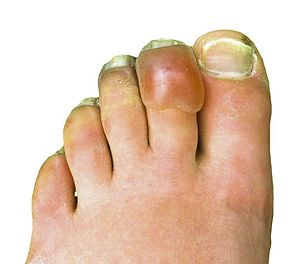Frostbite
| Frostbite | |
|---|---|
 |
|
| Frostbitten toes two to three days after mountain climbing | |
| Classification and external resources | |
| Specialty | Emergency medicine, orthopedics |
| ICD-10 | T33-T35 |
| ICD-9-CM | 991.0-991.3 |
| DiseasesDB | 31167 |
| MedlinePlus | 000057 |
| eMedicine | emerg/209 med/2815 derm/833 ped/803 |
| Patient UK | Frostbite |
| MeSH | D005627 |
Frostbite or cold burn is the medical condition in which localized damage is caused to skin and other tissues due to freezing. Frostbite is most likely to happen in body parts farthest from the heart and those with large exposed areas. The initial stages of frostbite are sometimes called frostnip.
The several classifications for tissue damage caused by extreme cold include:
At or below 0 °C (32 °F), blood vessels close to the skin start to constrict, and blood is shunted away from the extremities via the action of glomus bodies. The same response may also be a result of exposure to high winds. This constriction helps to preserve core body temperature. In extreme cold, or when the body is exposed to cold for long periods, this protective strategy can reduce blood flow in some areas of the body to dangerously low levels. This lack of blood leads to the eventual freezing and death of skin tissue in the affected areas. Of the four degrees of frostbite, each has varying degrees of pain.
This is called frostnip and only affects the surface of the skin, which is frozen. On the onset, itching and pain occur, and then the skin develops white, red, and yellow patches and becomes numb. The area affected by frostnip usually does not become permanently damaged, as only the skin's top layers are affected. Long-term insensitivity to both heat and cold can sometimes happen after suffering from frostnip.
If freezing continues, the skin may freeze and harden, but the deep tissues are not affected and remain soft and normal. Second-degree injury usually blisters 1–2 days after becoming frozen. The blisters may become hard and blackened, but usually appear worse than they are. Most of the injuries heal in one month, but the area may become permanently insensitive to both heat and cold.
If the area freezes further, deep frostbite occurs. The muscles, tendons, blood vessels, and nerves all freeze. The skin is hard, feels waxy, and use of the area is lost temporarily, and in severe cases, permanently. The deep frostbite results in areas of purplish blisters which turn black and which are generally blood-filled. Nerve damage in the area can result in a loss of feeling. This extreme frostbite may result in fingers and toes being amputated if the area becomes gangrenous. If the frostbite has gone on untreated, they may fall off. The extent of the damage done to the area by the freezing process of the frostbite may take several months to assess, and this often delays surgery to remove the dead tissue.
...
Wikipedia
